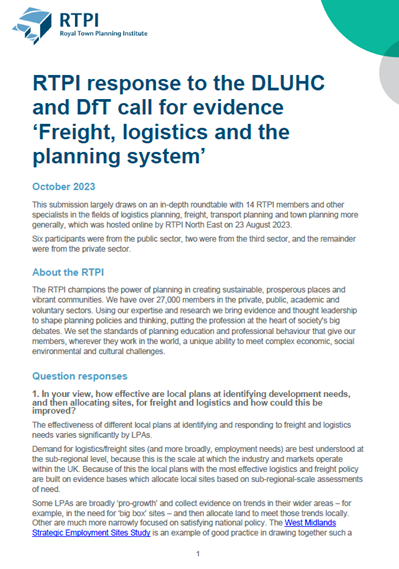 This submission largely draws on an in-depth roundtable with 14 RTPI members and other specialists in the fields of logistics planning, freight, transport planning and town planning more generally, which was hosted online by RTPI North East on 23 August 2023.
This submission largely draws on an in-depth roundtable with 14 RTPI members and other specialists in the fields of logistics planning, freight, transport planning and town planning more generally, which was hosted online by RTPI North East on 23 August 2023.
Six participants were from the public sector, two were from the third sector, and the remainder were from the private sector.
About the RTPI
The RTPI champions the power of planning in creating sustainable, prosperous places and vibrant communities. We have over 27,000 members in the private, public, academic and voluntary sectors. Using our expertise and research we bring evidence and thought leadership to shape planning policies and thinking, putting the profession at the heart of society's big debates. We set the standards of planning education and professional behaviour that give our members, wherever they work in the world, a unique ability to meet complex economic, social environmental and cultural challenges.
Question responses
1. In your view, how effective are local plans at identifying development needs, and then allocating sites, for freight and logistics and how could this be improved?
The effectiveness of different local plans at identifying and responding to freight and logistics needs varies significantly by LPAs.
Demand for logistics/freight sites (and more broadly, employment needs) are best understood at the sub-regional level, because this is the scale at which the industry and markets operate within the UK. Because of this the local plans with the most effective logistics and freight policy are built on evidence bases which allocate local sites based on sub-regional-scale assessments of need.
Some LPAs are broadly ‘pro-growth’ and collect evidence on trends in their wider areas – for example, in the need for ‘big box’ sites – and then allocate land to meet those trends locally. Other are much more narrowly focused on satisfying national policy. The West Midlands Strategic Employment Sites Study is an example of good practice in drawing together such a city-region level needs assessment. So is Liverpool City Region’s Strategic Housing and Employment Land Market Assessment.
Despite this, there are currently no firm requirements for LPAs to base their local plan allocations for freight on logistics on city region or region-level assessments of need.
As a result, it is widely felt that industrial demand studies are not fit for purpose. Their key issue is that they forecast demand based on historical trends – but a greater supply of industrial space would bring forward more investment as it becomes available.
To resolve these issues National Planning Practice Guidance should make much clearer that local plan policy for logistics and freight site allocations should be built on city region-level evidence bases.
2. How effectively are the policies in national planning policy (Chapter 6) and associated practice guidance applied by plan makers in supporting the needs of freight and how could this be improved?
Different LPAs can have very different interpretations of the National Planning Practice Guidance (NPPG). The robustness of evidence bases developed therefore also vary as great deal too. This is despite the fact that the parts of the NPPF that directly concern logistics and freight are, in themselves, strong enough to support effective planning at the local level. Overall, there was a general perception in our roundtable with expert members that the NPPG is weaker on the subject than the NPPF.
Taken as a whole, however, national planning policy in England currently disproportionately prioritises the delivery of private-market housing over other national priorities, including freight infrastructure. This is despite the fact that housing and employment are intrinsically linked, with logistics being a major employer in the UK (‘The Impact of Logistics Sites in the UK’, Frontier Economics, 2022). It is unsustainable to deliver new homes without access to employment opportunities. In the words of one participant ‘one cannot own a home without a job’. Our 2021 report, ‘The Location of Development’, shows significant variance across regions in accessibility to large employment centres. While in London, the average public transport journey time from large, planned developments to large employment sites is 23.7 minutes, in the South West, the journey takes over 40 minutes. National policy should make the links between housing and employment land clearer (particularly the role of logistics developments in supporting new housing),and strike a better balance. In London, for example ‘in the past 20 years, 24 per cent of industrial floor space [which is used for logistics] in the capital has been released to other uses, mainly housing.’ (‘Industrial and Logistics: Can London Deliver?’, NLA, 2023).
3. How effective is engagement between industry and local authorities in the course of local plan making? How can this be improved?
More and better market-facing intelligence on the needs of the sector would enable local authorities to and national government to develop more effective and responsive national and local or sub-regional policy. A significant amount of employment land coming forwards doesn’t meet the modern needs of the sector.
While engagement between industry and local authorities is crucial, that between local authorities and the general public on logistics/freight needs is equally important. Our roundtable participants felt that this is however an area that is often overlooked and under-appreciated. Several participants, from both the public and private sectors, argued that the public are not aware of how important these developments are as day-to-day infrastructure that supports modern lifestyles (in the words of one participant ‘perceptions are not keeping up with reality’), or the job opportunities they bring - either directly or indirectly, by supporting other employers to grow. Similarly, the low profile of the industry can mean that communities only get involved at planning application-phase, when it is too late for them to feel a sense of procedural fairness.
This could be improved by more focus on public education and awareness-building during local plan consultation processes, and by putting more emphasis on this in the NPPG (which currently neglects engagement as part of the logistics planning processes).
Commercial imperatives mean that only very specific locations are suitable for logistics/freight developments, and there are very few site options for meeting the industry’s needs. This means public engagement should focus on a) education about the economic benefits of these developments, and b) the community benefits which they can bring about, such as new facilities and training opportunities. Because developers are aware that there are very few and specific sites suitable for logistics/freight developments, and that ‘big box’ developments can be controversial, they are often very willing to be positive about community benefits, but local authorities (with communities) should be more proactive in seeking these.
The noise and traffic impacts of new logistics/freight developments can be of great concern to communities. Because of this it is crucial that more developers identify those risks as early as possible in the development process and communicate to communities clear plans for mitigating them.
4. How effectively does planning currently support efficient use of established freight and logistics infrastructure? How could it better support existing infrastructure?
Much existing rail freight infrastructure is in need of upgrade to modern commercial standards. This would draw in greater private sector investment in new sites. But repeated changes to national upgrade programmes can cause serious uncertainty, limiting private sector investment.
Local and national planning policy and guidance should do more to ensure that in edge-of-urban areas new logistics/freight developments are used to unlock (or maintain) local public and active travel networks. An example is the provision of infrastructure that encourages the use of electric bikes and vans for last-mile deliveries. There are significant opportunities here to deliver across a range of government policy objectives related to active travel, connectivity, etc.
5. How should freight and logistics be factored into statutory local transport plans and sub-national transport strategies?
Local transport plans
Local transport plans face several key issues that undermine the effective delivery of new freight and logistics schemes. Too often they:
- Are heavily reliant on ‘boilerplate text’ in policy, rather than responding to genuine local conditions and needs;
- Mention freight in particular as an afterthought; and
- Focus too heavily on the negative externalities associated with new logistics/freight developments (e.g. emissions and safety), and not the role new developments can play in meeting local and national policy objectives, such as decarbonisation and energy efficiency.
The long-overdue new national guidance for local transport plans should be an opportunity for addressing some of these concerns.
Sub-national transport bodies
Some sub-national transport bodies are regarded as being instrumental in the development of the valuable strategic, multi-local authority level evidence based we discussed in response to question 1. However, government should provide clearer guidance on how this should influence local transport plans, local plans and forthcoming local infrastructure strategies.
In general, government should make clear what the exact role of sub-national transport bodies is in relation to other actors.
Government should also encourage sub-national transport bodies and local transport plans to consider how micro-scale consolidation hubs, and low-carbon or active transport such as cargo bikes, could play a greater role in city-regional logistics networks and the drive for zero carbon and denser settlement patters. This may have implications for the built environment and town planning (for example, ensuring that mixed use developments provide the space for delivery and collection), and will therefore require engagement with LPAs.
6. What aspects of the applications and decision-taking process work well and what aspects do not work well?
The way that logistics assessments are conducted can result in job creation figures being lower than they really are, and this can prejudice decision making. This is because, while new logistics developments do support relatively few new jobs in themselves, they are crucial to driving growth and productivity in other sectors. These important indirect impacts are rarely taken into account in these assessments. Better national guidance on how to conduct these assessments would be helpful in making the case for new developments, especially when the negative impacts can be so easy to visualise or quantify.
Severe under resourcing in local authorities reduces the level of expertise in this field, which undermines the quality of decision making. Our research shows that local authorities’ net investment in planning stands at just £400million per year (or £1.2 million per local planning authority) (‘Resourcing Public Planning’, RTPI, 2019). Budget reductions have led to unmanageable workloads, resulting in the departure of a quarter of planners from the public sector between 2013 and 2020 (‘Interim State of the Profession’, RTPI, 2023). These challenges have had a particularly severe impact on plan-making and policy making functions of local planning authorities. Often public bodies are competing for a very limited pool of experts across the region.
7. How effective is the planning system at addressing the operational needs of the freight and logistics sector and how could this be improved? How could a national freight network be recognised in national planning policy?
A national freight network being described in national policy could provide more clarity, particularly on:
- How sub-regional networks link to global or international networks, and how the needs of this can be planned for at the local level; and
- The needs case in specific circumstances (this would help to address the point we make in response to question 5 about bias towards negative externalities over the benefits of new freight/logistics developments)
The government should provide more direction on nationally important locations for freight/logistics development within a national network. This is one way in which the designation of ‘freeports’ has proven valuable, but locations outside of these should also be identified. These areas may be ‘corridors’ (as in EU-era transport system planning) or ‘points’ and ‘nodes’.
8. How can the planning system support our net zero ambition for freight and logistics?
The emergence of the need for last-mile logistics hubs in dense urban areas requires planning policy that supports mixed-use development and flexible repurposing of underused space (such as retail and car parks) (‘Industrial and Logistics: Can London Deliver?’, NLA, 2023). Indeed, quieter, cleaner electric vehicles (which central government-set standards on the provision of electric and hydrogen would help to provide – see below), will open up the possibility to locate logistics facilities closer to residential areas.
Incorporating last-mile parcel hubs into mixed-use developments in high streets and town centres could be an important way of regenerating some neighbourhoods. In addition to environmental and economic benefits, mixed-use developments could also bring about social benefits, such as safer neighbourhoods and proximity between jobs and homes (see response to Question 2). In a Lichfields report (‘Going the last mile’, 2018), respondents from local authorities identified policy flexibility, site availability and sector-specific plan policies as the most important factors in planning for the growth of last-mile logistics.
In the absence of strong policy, the sector (and particularly the occupants of freight/logistics sites in development) has taken the lead on decarbonisation initiatives. But to ensure that the sector invests in the right infrastructure and technology, government should give a much stronger national steer on these priorities through the NPPF and guidance. Particularly for the use of electric vans and bikes for last-mile deliveries, the industry has expressed the needs for space for charging points at industrial sites (‘Industrial and Logistics: Can London Deliver?’, NLA, 2023).
Guidance can also be directed to the installation of solar panels on warehouses’ roof space. Currently, fewer than 5% of warehouses have photovoltaics despite their large roof areas offering great potential for the generation of renewable energy (‘Industrial and Logistics: Can London Deliver?’, NLA, 2023).
9. What more could local plans and decisions do to facilitate the supply of high-quality HGV parking and driver facilities?
Again, the key thing the government can do is to clearly map out the sub-regional and national need for these kind of developments, and the role they play in meeting national objectives, so that when new proposals come forwards these can be properly balanced against local harms. Otherwise nationally or sub-regionally important infrastructure can be blocked for very specific local reasons (obviously, in some cases this is right and proper).
Guidance should make clear that proper provision for these facilities should be made through the site allocation process. Doing this effectively relies on a strong sub-regional evidence base concerning need, size, type, and location, as we argued in response to question 1.
10. How can planning policy in England help to support the freight and logistics sector across the whole of the UK?
At the national level, policy should be joined-up through collaboration between all of the UK nations. In the words of one roundtable participant ‘English ports may be in England, [but they] are ports for the UK’.
National planning policy in England should encourage demand to be spread through the whole of the country, not a limited number of locations in the South of England that receive significant public sector investment but are struggling to meet demand.


